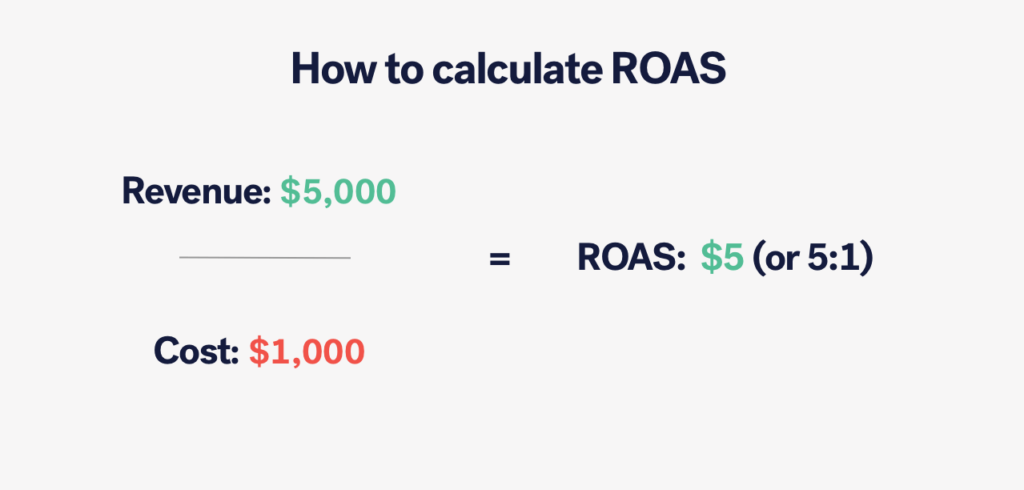What You Need to Know about the Difference between ROI and ROAS
When you’re running an e-commerce business, there are many metrics to consider to keep your business running, making revenues, and profits.
Among these metrics are two often mixed up terms. They are: return on investment (ROI) and return on ad spend (ROAS).
Let’s focus on the difference between ROI and ROAS and how e-commerce businesses can use each of them and when they should.
What is ROI?
Return on investment (ROI) is metric that measures the performance of an investment.
Investopedia explains ROI as a metric used to “evaluate the efficiency or profitability of an investment or compare the efficiency of a number of different investments.”
Businesses who use ROI try to see whether the investment they made was a good one or not.
ROI is calculated by dividing the investment’s net profit (or loss) by the initial cost. The result is a percentage.
This is what the equation looks like:

It also looks like this:
ROI = profits-costs / costs x 100 = %
Here’s an example of ROI:
Kelly invested $1,000 in a business venture and sold it for $1,300 a year later. To calculate the ROI, we’d have to divide the net profit (the $1,300 – $1,000 = $300) by the investment ($1,000). This would result in an ROI of $300/$1,000, or 30%.
ROI can be used for a variety of things, although most businesses use it as a profitability measure. ROI was an investment measure before everything turned digital. Online businesses use it too.
However, there are some downsides to ROI. “While ROI is a simple and straightforward measure, it does not take into account the holding period or passage of time, and so it can miss opportunity costs of investing elsewhere,” notes Investopedia.
What is ROAS?
Return on ad spend (ROAS) is a metric that measures the impact of your marketing and advertising. Every dollar you spend on ads needs to translate into a return, a result.
ROAS is the metric that measures that result.
Whether you’re trying to track clicks or conversions, ROAS is what tells you if the dollars you’re spending are resulting in high value or not.
Stay on top of your ads and read Facebook Ad Frequency: The Complete Guide for 2021
ROAS is how your business benefits from every dollar you spend on advertising messages and ads. The higher your revenue from dollars spent on ads, the better your ROAS.
The important thing about calculating ROAS is to know how much you are spending on ads and how much are you earning in return.
How to calculate ROAS
To calculate return on ad spend, you’ll need to divide your conversion value by the total amount of your advertising (or your advertising costs).

But what is a conversion value?
The conversion value measures the revenue your business can generate from a single conversion.
This means that the ROAS formula can also look like this:
ROAS = revenue from ad campaign (divided by) cost of ad campaign = Ratio x100 = %
Let’s explain this better with an example:
If John spends $20 on advertising to sell a $100 product, then his ROAS is 5:1 or $5. That’s $5 in ROAS for every dollar spent to sell John’s product.
If your ROAS is less than one, it means you’re not making money; you’re losing money.
If your ROAS is $1, that is $1 earned for every $1 spent, it means you’re breaking even, which again isn’t a good indicator. But you’re not losing money.
But if your ROAS is above $3 for example, then for every $1 you spend, you’re getting $3 back and you’re making a profit. (That’s a 200% return on ad spend).
Discover the 46 E-commerce Vocabulary, Metrics and Biz Terms You Need to Know
If your e-commerce strategy is to achieve profit, then your goal would be to achieve the highest ROAS possible for your business. You’ll need to know what the average ROAS is for your industry so you can see how you average accordingly.
However, the target ROAS benchmarks are usually between 3.0 and 4.0. Again, these can differ based on the industry and the stage where the business is at. Larger businesses can enjoy good profits at a ROAS of 3.0, while smaller businesses might need to achieve a ROAS of 5.0 or more.
The difference between ROI and ROAS
You now have a brief idea of the difference between ROI and ROAS.
Do they sound similar?
Yes.
Are they similar?
Yes. And No.
The main difference between ROI and ROAS is that ROI measures the value of an entire investment. Yes, that investment can be ads as well. But it can also be an investment in a new business, a factory expansion, a new department, and so on.
ROI is profitability measure. It takes into account other types of spending, like new software for your business.
ROAS, on the other hand, is specifically about your ad spend and its performance. It won’t tell you if your ad spend translated into profit for your business.
Here’s another example that shows the difference between ROI and ROAS on application.
XYZ company spends $25,000 in ads and generates $100,000 in revenue from its ad campaign. However, it has other expenses such as software and personnel amounting to $90,000.
To calculate the ROAS: Revenue of ad campaign – cost = ratio x 100 = %
($100,000/$25,000) x100 = 400%
To calculate the ROI: profits-costs / costs x 100 = %
Profits (loss) = $100,000 – $25,000 – $90,000 = -$15,000
Costs = $25,000 + $90,000 = $115,000
-$15,000 – $115,000 x 100 = – 13%
As you can see, the ROAS is showing stellar performance. But once it’s included alongside other expenses to calculate the ROI, we see negative performance or negative ROI.
By calculating ROI, we can see that XYZ Company is making a loss.

Another major difference between ROI and ROAS is that ROI is about the money you make after deducting all your expenses, whereas ROAS compares between how much you’re spending and how much you’re making on ads only.
The sole purpose of ROI is to determine whether the campaign is worth the investment or not. By taking the margin into account, you can quickly determine your overall profits and determine what your actual ROI is.
The bigger picture of ROAS and ROI
ROAS focuses on advertising and its results. It helps businesses determine if their advertising efforts are paying off or not.
By focusing on ROAS, e-commerce businesses can make better future decisions, see where they need to invest their dollars, and how to better invest them.
That said, relying on ROAS only can be misleading for a business.
Why? Because ROAS is about advertising results only. Your ad campaigns may be resulting in a high conversion rate, but the cost of each conversion is quite high resulting in an overall loss for the company.
Power up your business and learn more about your customers with these 34 e-commerce quotes by industry experts
An example of this is a business selling a product for $30 but generating leads at $50 per lead. Each translates into a $20 loss for the company.
The loss doesn’t necessarily have to be in the cost of the lead in the ad campaign. The loss may come from additional aspects such as production and shipping.
This is where ROI comes in. It factors in the other expenses that aren’t just related to the ad spend.
“When you consider ROI vs. ROAS, it’s important to remember that it isn’t an either/or situation. Whereas ROI can help you understand long-term profitability, ROAS may be more suited to optimizing short-term strategy,” notes GoCardless.
Read more: 15 ways to Increase Your eCommerce ROAS
Next steps
There are many differences between ROI and ROAS. As a business you can’t rely on just one metric.
We recommend using both. Use ROAS to see how your ad campaigns are performing, then use ROI to see how your overall marketing budget and other expenses fit in the equation.
This means that an effective digital marketing campaign would rely on both ROI and ROAS.
Another metric you should include in your digital marketing efforts is customer lifetime value (CLV). CLV combined with ROI can offer great results for your business.
Want to know more about the metrics and means to help your e-commerce business? Tell us what you’re struggling with in the comments and we’ll share our tips with you.
Want to read more? Discover everything You Need to Know About Ecommerce ROI


